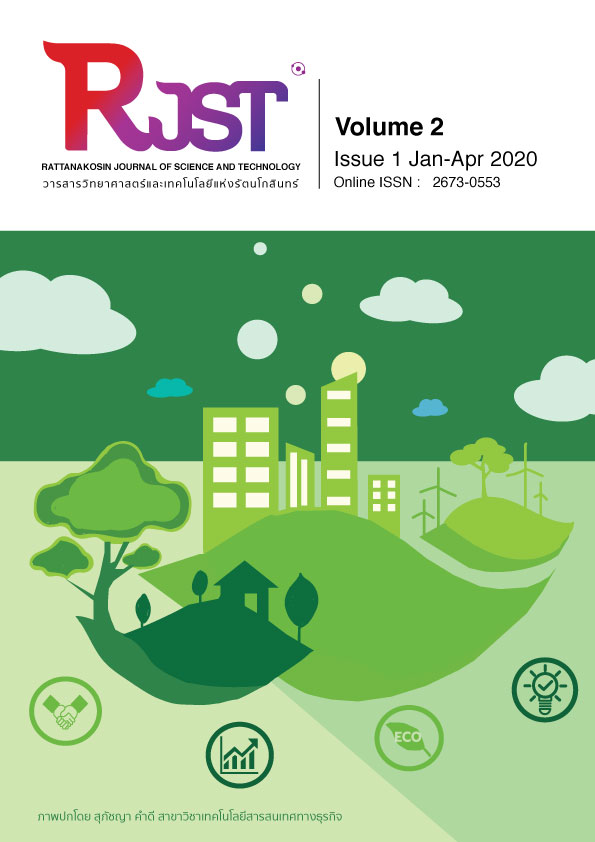The Control of the Production of Air Ducts for Reducing Waste and Applying (A case study of 1000 DUCT RATTANABURI COMPANY LIMITED)
Main Article Content
Abstract
This research studies the method of air duct production control to reduce waste through studying, modifying, and applying to be able to reduce zinc scraps from the production of air ducts and to improve the production using equipment modification and application, using the remaining zinc scrap as various components of the air duct to study the possibility, and analyze the cause and solutions by comparing the data before and after the improvement of the air duct production.
The result of the study was in accordance with the main objectives, which is studying the methods of air duct production control for reducing waste and applying and to study the causes and solutions of air duct production within the data collecting period of 3 months to achieve the objectives. Before the improvement, the total amount of zinc scrap was 19,120 kilograms or 39.89 percent, and after the improvement, the total amount of zinc scrap was 10,160 kilograms, equivalent to 21.16 percent, which can lead to the conclusion that replacing the old tools made from non-standard zinc scraps to new standardized tools, and using the zinc scraps as the air duct components can cause a reduction of the zinc scraps. The improvements of the air ducts production can reduce the zinc scrap from 39.83% to 21.16%, decreasing by 18.67%, or from 19,120 kilograms to 10,160 kilograms.
Article Details
The content within the published articles, including images and tables, is copyrighted by Rajamangala University of Technology Rattanakosin. Any use of the article's content, text, ideas, images, or tables for commercial purposes in various formats requires permission from the journal's editorial board.
Rajamangala University of Technology Rattanakosin permits the use and dissemination of article files under the condition that proper attribution to the journal is provided and the content is not used for commercial purposes.
The opinions and views expressed in the articles are solely those of the respective authors and are not associated with Rajamangala University of Technology Rattanakosin or other faculty members in the university. The authors bear full responsibility for the content of their articles, including any errors, and are responsible for the content and editorial review. The editorial board is not responsible for the content or views expressed in the articles.
References
[2] จักรพงษ์ เพ็งแจ่มแจ้ง. 2554. การปรับปรุงการบํารุงรักษาเพื่อเพิ่มประสิทธิภาพสําหรับเครื่องปรับอากาศแบบแยกส่วน. สาขาวิชาการจัดการทางวิศวกรรม วิทยาลัยนวัตกรรมด้านเทคโนโลยีและวิศวกรรมศาสตร์. มหาวิทยาลัยธุรกิจบัณฑิตย์. กรุงเทพฯ.
[3] ดุลยโชติ ชลศึกษ์. 2557. การออกแบบท่อลมทางวิศวกรรม. สาขาวิชาวิศวกรเครื่องกล คณะวิศวกรรมศาสตร์ มหาวิทยาลัยธรรมศาสตร์. กรุงเทพฯ.
[4] นัฏฐวิกา จันทร์ศรี. 2555. การออกแบบและพัฒนาชิ้นส่วนเครื่องปรับอากาศเพื่อลดต้นทุน. สาขาวิชาวิศวกรรมการจัดการคณะวิศวกรรมศาสตร์ศรีราชา มหาวิทยาลัยเกษตรศาสตร์. กรุงเทพฯ.
[5] อรวรรณ สุขวานนท์. 2560. การลดต้นทุนโดยใช้เทคนิควิศวกรรมคุณค่ากรณีศึกษาชิ้นส่วนของระบบปรับอากาศ รถยนต์. สาขาวิชาการจัดการงานวิศวกรรม คณะวิศวกรรมศาสตร์. มหาวิทยาลัยบูรพา ชลบุรี.
[6] สมจินต์ อักษรธรรม. 2561. ผังเหตุและผล. วารสารวิชาการมหาวิทยาลัยธนบุรี. กรุงเทพฯ.
[7] สายฝน ยาเงิน. 2562. การวิเคราะห์เมื่อมีการเปลี่ยนแปลงเครื่องมือและต้นทุน. บริษัท 1000 ดักท์รัตนบุรี จำกัด นครปฐม.
[8] มีชัย เรามานะชัย. 2557. หลักความคิดวิศวกรรมคุณค่า. ออนไลน์. แหล่งที่มา: www.etHesisarchive.library.tu.ac.th (27 พฤษจิกายน 2562)


